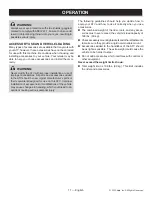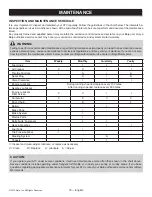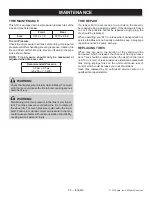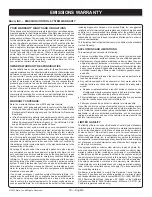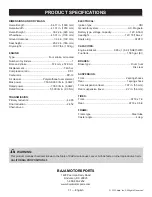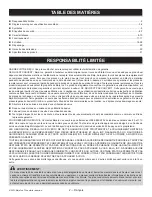
©
2010 Baja, Inc. All Rights Reserved.
27 — English
MAINTENANCE
GENERAL LUBRICATION
Proper lubrication is important for safe, smooth operation
and long life of your vehicle. Be sure that all lubrication
is performed during periodic maintenance on the vehicle.
Increase number of intervals when you use your ATV in
severe conditions. Your authorized service center should do
the general lubrication as shown in the Maintenance chart.
This includes the lubrication of wheel bearings, swing arm
bearings, steering shaft holder, cables, etc.
Lubricate the following areas with oil or grease as indi-
cated.
Bottom fitting of steering shaft -- lubricate with lithium (Li)
based grease
Brake cable
Throttle cable
Throttle lever
TRANSPORTING
It is best to transfer the ATV in its normal operating posi
-
tion.
Drain fuel from carburetor.
● Turn fuel valve to the off position.
●
Turn off the engine.
● Place a suitable container beneath the carburetor drain
screw.
●
Loosen the screw and allow the fuel from the carburetor
to drain completely.
●
Retighten the carburetor drain screw.
Lock the parking brake lever.
Securely tie down the ATV at the four wheels with straps,
rope, or some other suitable means. Use extra tie downs
if you transfer the vehicle in the standing position.
CLEANING
A thorough cleaning of the ATV is a necessary part of mainte-
nance. It will help keep the ATV looking and performing at its
best. Proper cleaning can also extend the life of the ATV.
Clean and inspect the ATV after every ride, especially if it is
used in mud, brush, grass, water, salt water, or very dusty
conditions. The build-up of mud, brush, grass, etc., especially
on the engine and exhaust system, can reduce engine cooling
ability, conceal damage, or increase wear of certain parts.
Remove all debris during cleaning.
The ATV should be washed before any mud dries on the
unit. Avoid spraying or allowing water to flow over the ignition
switch, spark plug, fuel tank cap, carburetor, or air filter.
NOTE:
Do not use high pressure washers such as those
found at car washes. They could cause mechanical, electri-
cal and other damage.
Block or seal the end of the muffler exhaust pipe using a
piece of plastic wrap or cloth to prevent water from enter
-
ing the engine.
Hand wash the unit with mild soap or detergent and water.
Try to thoroughly remove all dirt and debris without exces
-
sive water pressure, even at remote areas such as be
-
tween engine cooling fins, linkages, or mounting brackets.
Cloth rags, washing mitts, or cleaning brushes can be
used, but be careful with brushes as they can scratch
plastic or painted surfaces.
Rinse the unit thoroughly with clean water.
Dry all areas using a chamois or soft absorbent cloth.
Remove the rags or wrapping from the exhaust pipe.





